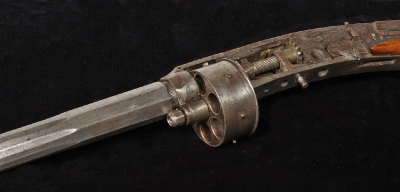Revolving musket (1884.27.75)
This musket with a six-chambered revolving cylinder was probably an inventor’s model made about 1840 and later acquired by Pitt-Rivers. He may himself have removed the plate to show the needle-type mechanism. This needle action is in contrast to the hammer used by standard small revolvers of the day.
The idea of using a revolving cylinder to increase the rate of fire was not a new idea - Hans Stopler made a revolving snaphance arquebus in 1597 and there are other examples of revolving wheel-locks from that era. James Puckle patented a a hand-cranked revolving chamber gun in 1718 which, able to fire more than sixty rounds in seven minutes, has been referred to as the world's first 'machine gun'.
Manufacturers such as Tranter, Le Mat, and Colt all attempted to design revolving rifles, but the fact was that the revolving chamber principle was not as successful in long guns as it had been in the handgun market; they were cumbersome, discharged hot gas near the face, and a stray spark could set off all the chambers at once. They would also have been unsuitable for military use due to the build up of dirt and debris in the ‘open’ parts of the cylinder. It was not until the development of the box magazine for lever- and bolt-action guns in the 1880s that repeating rifles became safer and more effective.





